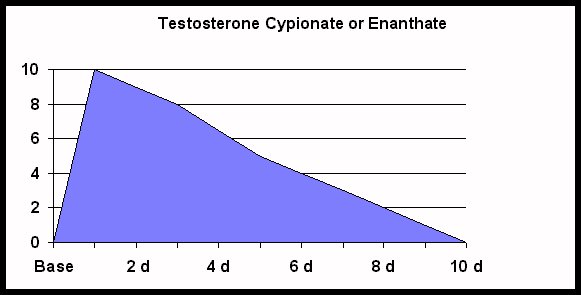I must of missed this thread the first go around, but I thought I should defend myself (I am Roy Harper).
First off, half-lives can only be generalized. There is no universal half-live that applies to everyone. Women, men, hypogondal men, rats, etc. will all metabolize drugs at a diffrent rate. If you have high levels of 5-AA reductase you'll metabolize Test at a slower rate then those with lower levels. It all depends on the enzyme profile of the individual.
Secondly, blood levels are not the be all end all sign of steroid levels. Why? Because like many other chemicals, large amounts are stored in body fat not just blood. I know I wrote an article called "Calculating Blood Levels of Steroids", but this was the best title. Furthermore steroids can metabolized, in most cases, forwrds and backwards. So if Test is converted to DHT it can be converted back to Test. There is no linear matebolic pathway for every steroid. Moreover there are thousands of metabolic pathways for every steroid.
Thirdly, the 1.5 rule is a *general* rule, not an exact one. Of course I did not make this up, it is from that field of science called pharmacology. Many other pharmacologists have mentioned and use this rule, note I did not say steroid gurus. This rule works for the general population, but once again 250lbs bodybuilders are going show different results than a 100lbs women.
Fourthly, there are few studies done on 250lbs bodybuilders. Most are on women, hypogondal men, etc. We cannot extrapolate half-lifes from these studies and assume they will apply directly to us. IMO half-lives are only a guide, one should experiment to see what works best for themself.
Lastely, there are studies that disprove and prove any theory.
J Androl 1998 Nov-Dec;19(6):761-8 Related Articles, Books
A pharmacokinetic study of injectable testosterone undecanoate in hypogonadal men.
Zhang GY, Gu YQ, Wang XH, Cui YG, Bremner WJ.
National Research Institute for Family Planning (World Health Organization Collaborating Center for Research in Human Reproduction), Beijing, People's Republic of China.
Testosterone undecanoate (TU) provides testosterone (T) replacement for hypogonadal men when administered orally but requires multiple doses per day and produces widely variable serum T levels. We investigated the pharmacokinetics of a newly available TU preparation administered by intramuscular injection to hypogonadal men. Eight patients with Klinefelter's syndrome received either 500 mg or 1,000 mg of TU by intramuscular injection; 3 months later, the other dose was given to each man (except to one, who did not receive the 1,000-mg dose). Serum levels of reproductive hormones were measured at regular intervals before and after the injections. Mean serum T levels increased significantly at the end of the first week, from less than 10 nmol/L to 47.8+/-10.1 and 54.2+/-4.8 nmol/ L for the lower and higher doses, respectively. Thereafter, serum T levels decreased progressively and reached the lower-normal limit for adult men by day 50 to 60. Pharmacokinetic analysis showed a terminal elimination half-life of 18.3+/-2.3 and 23.7+/-2.7 days and showed a mean residence time of 21.7+/-1.1 and 23.0+/-0.8 days for the lower and higher doses, respectively. The area under the serum T concentration-time curve and the T-distribution value related to serum T concentration were significantly higher following the 1,000-mg dose than following the 500-mg dose. The 500-mg dose, when given as the second injection, yielded optimal pharmacokinetics (defined as mean peak T values not exceeding the normal range and persistence of normal levels for at least 7 weeks), suggesting that repeated injections of 500 mg at 6-8-week intervals may provide optimal T replacement. The mean serum levels of estradiol were normalized following the injections, and prolactin levels were normal throughout the study. Significant decrease of serum luteinizing hormone (LH) and follicle-stimulating hormone (FSH) levels was observed, with the decrease in LH levels being more pronounced. There were no significant differences in serum LH and FSH levels between the two doses. Sex hormone-binding globulin (SHBG) levels before any T therapy were near the upper limit of normal for adult men and were reduced by approximately 50% just prior to the second dose of TU. The decreased SHBG levels produced by the first TU injection could have led to lower peak total T levels and to a more rapid clearance of T following the second TU injection. We conclude that single-dose injections of TU to hypogonadal men can maintain serum T concentration within the normal range for at least 7 weeks without immediately apparent side effects. It is likely that this form of T would require injections only at 6-8-week or longer intervals, not at the 2-week intervals necessary with currently used T esters (enanthate and cypionate). This injectable TU preparation may provide improved substitution therapy for male hypogonadism and, in addition, may be developed as an androgen component of male contraceptives.



 Please Scroll Down to See Forums Below
Please Scroll Down to See Forums Below 



.jpg)






.png)

